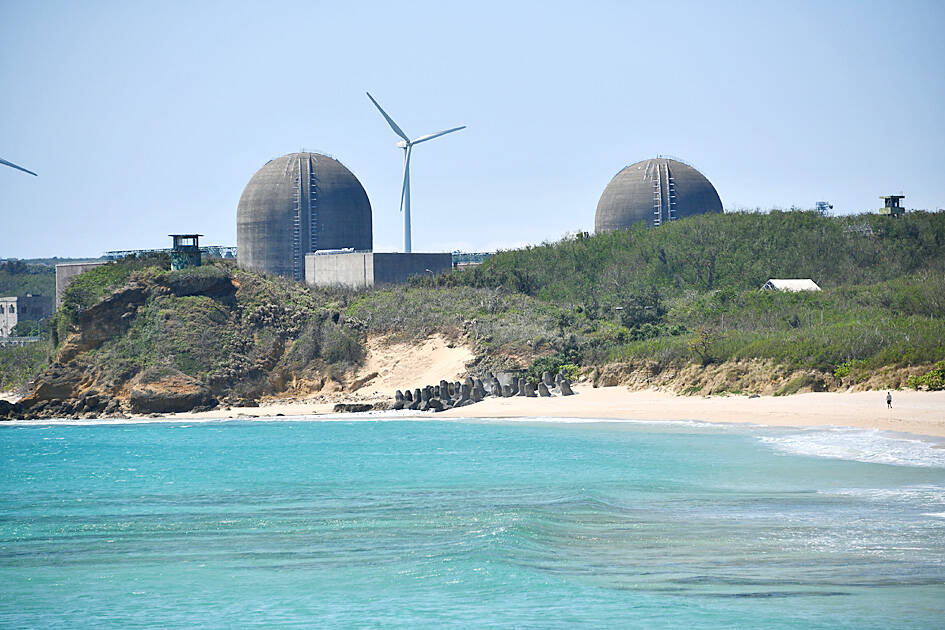Taiwan Power Co (Taipower, 台電) yesterday temporarily shut down the nation’s nuclear energy generation as the state-run utility started regular maintenance on the remaining reactor at the Ma-anshan Nuclear Power Plant for 41 days.
The No. 2 reactor of the nation’s only active nuclear plant in Pingtung County’s Hengchun Township (恆春) is set to be decommissioned next year. The No. 1 reactor has been offline since July.
The shutdown is to perform equipment maintenance and fuel replacement in preparation for the power plant’s next operating cycle, Taipower said in a statement.

Photo: Tsai Tsung-hsien, Taipei Times
With support from other energy sources, Taipower would ensure sufficient power supply during the 41-day period as it aims to maintain its operating reserve margin — or spare capacity at times of peak consumption — at 10 percent during the day and more than 7 percent at night, it said.
Taiwan is poised to become the first non-nuclear nation in East Asia after the No. 2 reactor closes down in May next year, although there is a continuing debate among ruling and opposition parties as well as within society about whether to extend the service life of the Ma-anshan plant amid fears about potential power shortages.
Nuclear power last year accounted for 6.31 percent of the nation’s energy use, which is dominated by coal at 42.24 percent and liquefied natural gas at 39.57 percent, while renewable energy only contributed about 9.47 percent and hydroelectricity 1.08 percent, Energy Administration data showed.
When the Democratic Progressive Party (DPP) took office in 2016, then-president Tsai Ing-wen (蔡英文) proposed a nuclear-free homeland policy by next year, setting a target energy mix of 50 percent natural gas, 30 percent coal and 20 percent renewable energy, but President William Lai (賴清德) is facing greater pressure to review the structure of the energy mix as public worries about the dangers of nuclear energy have been replaced by a fear of power shortages.
It comes as Taiwan’s power consumption is forecast to grow by an average of 2.8 percent per year through 2033, driven mainly by the ever-growing energy use in the artificial intelligence (AI) sector, and as the government aims to achieve net zero carbon emissions by 2050 to help combat climate change.
In an interview with Bloomberg News, Premier Cho Jung-tai (卓榮泰) said Taiwan is “very open” to using new nuclear technology to meet surging demand from chipmakers and the AI industry — one of the strongest signs yet that the DPP government is rethinking its opposition to nuclear energy.
“As long as there is a consensus within Taiwan on nuclear safety, and a good direction and guarantees for handling nuclear waste, with this strong consensus we can have a public discussion,” Cho said on Thursday last week.
“We hope that Taiwan can also catch up with global trends and new nuclear technologies,” the premier said, adding that he has asked Taipower to make sure that personnel related to the decommissioned reactors stay in their jobs.
“This is because we need to prepare for future nuclear technology developments and to respond to any potential legal changes in Taiwan,” Cho said.
Additional reporting by Bloomberg

TRAGEDY STRIKES TAIPEI: The suspect died after falling off a building after he threw smoke grenades into Taipei Main Station and went on a killing spree in Zhongshan A 27-year-old suspect allegedly threw smoke grenades in Taipei Main Station and then proceeded to Zhongshan MRT Station in a random killing spree that resulted in the death of the suspect and two other civilians, and seven injured, including one in critical condition, as of press time last night. The suspect, identified as a man surnamed Chang Wen (張文), allegedly began the attack at Taipei Main Station, the Taipei Fire Department said, adding that it received a report at 5:24pm that smoke grenades had been thrown in the station. One man in his 50s was rushed to hospital after a cardiac arrest

A car bomb killed a senior Russian general in southern Moscow yesterday morning, the latest high-profile army figure to be blown up in a blast that came just hours after Russian and Ukrainian delegates held separate talks in Miami on a plan to end the war. Kyiv has not commented on the incident, but Russian investigators said they were probing whether the blast was “linked” to “Ukrainian special forces.” The attack was similar to other assassinations of generals and pro-war figures that have either been claimed, or are widely believed to have been orchestrated, by Ukraine. Russian Lieutenant General Fanil Sarvarov, 56, head

SAFETY FIRST: Double the number of police were deployed at the Taipei Marathon, while other cities released plans to bolster public event safety Authorities across Taiwan have stepped up security measures ahead of Christmas and New Year events, following a knife and smoke bomb attack in Taipei on Friday that left four people dead and 11 injured. In a bid to prevent potential copycat incidents, police deployments have been expanded for large gatherings, transport hubs, and other crowded public spaces, according to official statements from police and city authorities. Taipei Mayor Chiang Wan-an (蔣萬安) said the city has “comprehensively raised security readiness” in crowded areas, increased police deployments with armed officers, and intensified patrols during weekends and nighttime hours. For large-scale events, security checkpoints and explosives

PUBLIC SAFETY: The premier said that security would be tightened in transport hubs, while President Lai commended the public for their bravery The government is to deploy more police, including rapid response units, in crowded public areas to ensure a swift response to any threats, President William Lai (賴清德) said yesterday after a knife attack killed three people and injured 11 in Taipei the previous day. Lai made the remarks following a briefing by the National Police Agency on the progress of the investigation, saying that the attack underscored the importance of cooperation in public security between the central and local governments. The attack unfolded in the early evening on Friday around Taipei Main Station’s M7 exit and later near the Taipei MRT’s Zhongshan